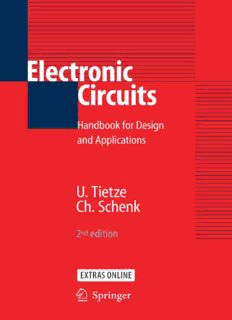Table Of ContentUlrichTietze • Christoph Schenk • Eberhard Gamm
Electronic Circuits
U. Tietze • Ch. Schenk • E. Gamm
Electronic Circuits
Handbook for Design and Application
2nd edition
with 1771Figures and CD-ROM
Dr.-Ing. UlrichTietze
LecturerattheTechnicalElectronicsInstitute
UniversityofErlangen-Nuernberg,Germany
Dr.-Ing. Christoph Schenk
GeneralManagerofDr.SchenkGmbH
Munic,Germany
Dr.-Ing. Eberhard Gamm
CommunicationsConsultant
Erlangen,Germany
www.tietze-schenk.com
[email protected]
Translationof
Tietze,U.;Schenk,Ch.:Halbleiter-Schaltungstechnik.12.edition,2002
Existingtranslations:
Polish:Naukowo-Techniczne,Warsaw1976,1987,1996
Hungarian:Müszaki,Budapest1974,1981,1990
Russian:Mir,Moscow1982,DodecaPublishin,Moscow2007
Spanish:Marcombo,Barcelona1983
Chinese:(bootleg)1985
English:Springer,Heidelberg1978,1991
Additional material to this book can be downloaded from http://extras.springer.com
ISBN 978-3-540-00429-5 ISBN 978-3-540-78655-9 (eBook)
DOI 10.1007/978-3-540-78655-9
LibraryofCongressControlNumber:2007936735
Thisworkissubjecttocopyright.Allrightsarereserved,whetherthewholeorpartofthematerialis
concerned,specificallytherightsoftranslation,reprinting,reuseofillustrations,recitation,broadcasting,
reproductiononmicrofilmorinanyotherway,andstorageindatabanks.Duplicationofthispublication
orpartsthereofispermittedonlyundertheprovisionsoftheGermanCopyrightLawofSeptember9,
1965,initscurrentversion,andpermissionforusemustalwaysbeobtainedfromSpringer.Violations
areliableforprosecutionundertheGermanCopyrightLaw.
Theuseofgeneraldescriptivenames,registerednames,trademarks,etc.inthispublicationdoesnotimply,
evenintheabsenceofaspecificstatement,thatsuchnamesareexemptfromtherelevantprotectivelaws
andregulationsandthereforefreeforgeneraluse.
Printedonacid-freepaper
987654321
springer.com
Preface
Thepurposeofthisbookistohelpthereadertounderstandoff-the-shelfcircuitsandto
enablehimtodesignhisorherowncircuitry.Thebookiswrittenforstudents,practicing
engineers and scientists. It covers all major aspects of analog and digital circuit design.
Thebookisatranslationofthecurrent12theditionoftheGermanbestsellerHalbleiter-
Schaltungstechnik.
PartIdescribessemiconductordevicesandtheirbehaviorwithrespecttothemodels
usedincircuitsimulation.Thispartintroducesallmajoraspectsoftransistorleveldesign
(IC-design).Basiccircuitsareanalyzedinfivesteps:large-signaltransfercharacteristic,
small-signal response, frequency response and bandwidth, noise and distortion. Digital
circuits are covered starting with the internal circuitry of gates and flip-flops up to the
constructionofcombinatorialandsequentiallogicsystemswithPLDsandFPGAs.Design
examplesandashortformguideforthedigitalsynthesistoolispLeverareincludedonthe
CDenclosed.
Part II is dedicated to board level design. The main chapters of this part describe
the use of operational amplifiers for signal conditioning including signal amplification,
filteringandAD-conversion.Furtherchapterscoverpoweramplifiers,powersuppliesand
otherimportantfunctionalblocksofanalogsystems.Thechaptersareself-containedwith
a minimum of cross-reference. This allows the advanced reader to familiarize himself
quicklywiththevariousareasofapplications.Eachchapteroffersadetailedoverviewof
varioussolutionstoagivenrequirement.Inordertoenablethereadertoproceedquickly
fromanideatoaworkingcircuit,wediscussonlythosesolutionswehavetestedthoroughly
bysimulation.ManyofthesesimulationexamplesareincludedontheCDenclosed.
PartIIIdescribescircuitsforanaloganddigitalcommunicationoverwirelesschan-
nels. The first chapter is dedicated to transmission channels, scattering parameters and
analoganddigitalmodulations.Furtherchapterstreatthearchitectureoftransmittersand
receivers,thehighfrequencybehaviorofcomponents,circuitsforimpedancematching,
highfrequencyamplifiersandmixersforfrequencyconversion.
To support analog circuit design, design examples and a short-form guide for the
well known circuit simulator PSpice are included on the CD. This package contains li-
brarieswithexamplesofscalabletransistorsforIC-likedesign.Thelibraryalsosupports
S-parameterandloop-gainsimulations.AnHTML-basedindexallowscomfortablenavi-
gationthroughoutthesimulations.
Ourhomepagewww.tietze-schenk.comoffersupdates,supplementsanddesignexam-
ples.We encourage you to use our email-address [email protected] for feedback
andcomments.
We would like to thank Dr. Merkle at Springer Heidelberg for the administration,
GerhardBüschingforthetranslationandDannyLewisatPTP-Berlinfortheassemblyof
thisbook.InparticularweliketothankDr.EberhardGammforthecontributionofthefirst
fourchaptersofcircuitdesignfundamentalsinpartIandthechaptersofcommunications
inpartIII.Wehaveaddedhimasayounginnovativeauthor.
Erlangen,July2007 U.Tietze,Ch.Schenk,E.Gamm
Overview
PartI.DeviceModelsandBasicCircuits 1
1. Diodes 3
2. BipolarTransistors 33
3. FieldEffectTransistors 169
4. Amplifiers 269
5. OperationalAmplifiers 483
6. LatchingCircuits 587
7. LogicFamilies 611
8. CombinatorialCircuits 635
9. SequentialLogicSystems 659
10. SemiconductorMemories 689
PartII.GeneralApplications 723
11. OperationalAmplifierApplications 725
12. ControlledSourcesandImpedanceConverters 767
13. ActiveFilters 787
14. SignalGenerators 843
15. PowerAmplifiers 867
16. PowerSupplies 885
17. AnalogSwitchesandSample-and-HoldCircuits 929
18. Digital-AnalogandAnalog-DigitalConverters 945
19. DigitalFilters 987
20. MeasurementCircuits 1031
21. SensorsandMeasurementSystems 1059
22. ElectronicControllers 1103
23. OptoelectronicComponents 1127
PartIII.CommunicationCircuits 1147
24. Basics 1149
25. TransmittersandReceivers 1237
26. PassiveComponents 1283
27. High-FrequencyAmplifiers 1321
28. Mixers 1363
29. Appendix 1431
Bibliography 1525
Index 1529
Contents
PartI.DeviceModelsandBasicCircuits 1
1. Diodes 3
1.1 PerformanceoftheDiode ....................................... 4
1.1.1 CharacteristicCurve .................................... 4
1.1.2 DescriptionbyEquations ................................ 5
1.1.3 SwitchingPerformance ................................. 8
1.1.4 Small-SignalResponse .................................. 10
1.1.5 LimitValuesandReverseCurrents ........................ 11
1.1.6 ThermalPerformance ................................... 12
1.1.7 TemperatureSensitivityofDiodeParameters ............... 12
1.2 ConstructionofaDiode ........................................ 13
1.2.1 DiscreteDiode ........................................ 13
1.2.2 IntegratedDiode ....................................... 15
1.3 ModelofaDiode ............................................. 16
1.3.1 StaticPerformance ..................................... 16
1.3.2 DynamicPerformance .................................. 19
1.3.3 Small-SignalModel .................................... 22
1.4 SpecialDiodesandTheirApplication ............................. 24
1.4.1 ZenerDiode ........................................... 24
1.4.2 PinDiode ............................................. 27
1.4.3 VaractorDiodes ........................................ 28
1.4.4 BridgeRectifier ........................................ 30
1.4.5 Mixer................................................. 31
2. BipolarTransistors 33
2.1 PerformanceofaBipolarTransistor............................... 34
2.1.1 Characteristics ......................................... 34
2.1.2 DescriptionbyWayofEquations.......................... 36
2.1.3 CharacteristicoftheCurrentGain ......................... 37
2.1.4 OperatingPointandSmall-SignalResponse ................ 39
2.1.5 LimitDataandReverseCurrents.......................... 45
2.1.6 ThermalPerformance ................................... 49
2.1.7 TemperatureSensitivityofTransistorParameters ............ 53
2.2 DesignofaBipolarTransistor ................................... 54
2.2.1 DiscreteTransistors .................................... 55
2.2.2 IntegratedTransistors ................................... 56
X Contents
2.3 ModelsofBipolarTransistors.................................... 58
2.3.1 StaticPerformance...................................... 58
2.3.2 DynamicPerformance .................................. 68
2.3.3 Small-SignalModel .................................... 73
2.3.4 Noise................................................. 82
2.4 BasicCircuits ................................................. 95
2.4.1 Common-EmitterCircuit ................................ 96
2.4.2 Common-CollectorCircuit............................... 131
2.4.3 Common-BaseCircuit................................... 148
2.4.4 DarlingtonCircuit ...................................... 159
3. FieldEffectTransistors 169
3.1 BehaviorofaFieldEffectTransistor ............................. 170
3.1.1 CharacteristicCurves ................................... 172
3.1.2 DescriptionbyEquations ................................ 175
3.1.3 FieldEffectTransistorasanAdjustableResistor............. 179
3.1.4 OperatingPointandSmall-SignalBehavior ................ 181
3.1.5 MaximumRatingsandLeakageCurrents................... 185
3.1.6 ThermalBehavior ...................................... 189
3.1.7 TemperatureSensitivityofFETParameters ................. 189
3.2 ConstructionoftheFieldEffectTransistor ......................... 192
3.2.1 IntegratedMOSFETs ................................... 192
3.2.2 DiscreteMOSFETs .................................... 194
3.2.3 JunctionFETs ......................................... 197
3.2.4 Cases................................................. 197
3.3 ModelsofFieldEffectTransistors ................................ 197
3.3.1 StaticBehavior......................................... 198
3.3.2 DynamicBehavior ..................................... 206
3.3.3 Small-SignalModel .................................... 215
3.3.4 Noise ................................................ 222
3.4 BasicCircuits ................................................ 229
3.4.1 Common-SourceCircuit ................................ 230
3.4.2 Common-DrainCircuit ................................. 252
3.4.3 Common-GateCircuit .................................. 261
4. Amplifiers 269
4.1 Circuits ...................................................... 271
4.1.1 CurrentSourcesandCurrentMirrors ...................... 277
4.1.2 Cascodecircuit......................................... 312
4.1.3 DifferentialAmplifier ................................... 327
4.1.4 ImpedanceConverters................................... 385
4.1.5 CircuitsforSettingtheOperatingPoint .................... 395
4.2 PropertiesandParameters....................................... 408
Contents XI
4.2.1 Characteristics ......................................... 409
4.2.2 Small-SignalCharacteristics.............................. 412
4.2.3 NonlinearParameters ................................... 426
4.2.4 Noise................................................. 443
5. OperationalAmplifiers 483
5.1 General ...................................................... 483
5.1.1 TypesofOperationalAmplifier ........................... 484
5.1.2 PrincipleofNegativeFeedback ........................... 487
5.2 NormalOperationalAmplifier(VV-OPA) ......................... 491
5.2.1 Principle .............................................. 492
5.2.2 MultipurposeAmplifiers................................. 494
5.2.3 OperatingVoltages...................................... 497
5.2.4 Single-SupplyAmplifiers ................................ 498
5.2.5 Rail-to-RailAmplifiers .................................. 500
5.2.6 Wide-BandOperationalAmplifiers ........................ 504
5.2.7 FrequencyCompensation ................................ 509
5.2.8 ParametersofOperationalAmplifiers ...................... 523
5.3 TransconductanceAmplifier(VC-OPA) ........................... 540
5.3.1 InternalConstruction.................................... 541
5.3.2 TypicalApplications .................................... 543
5.4 TransimpedanceAmplifier(CV-OPA) ............................ 544
5.4.1 InternalDesign......................................... 545
5.4.2 FrequencyResponse .................................... 550
5.4.3 TypicalApplications .................................... 551
5.5 TheCurrentAmplifier(CC-OPA) ................................ 552
5.5.1 TheInternalDesign..................................... 552
5.5.2 TypicalApplications .................................... 554
5.6 Comparison................................................... 568
5.6.1 PracticalImplementation ................................ 570
5.6.2 Types................................................. 572
6. LatchingCircuits 587
6.1 TransistorasSwitch............................................ 587
6.2 LatchingCircuitsUsingSaturatedTransistors ...................... 590
6.2.1 BistableCircuits........................................ 591
6.2.2 MonostableCircuits..................................... 593
6.2.3 AstableCircuits(Multivibrators) ......................... 594
6.3 LatchingCircuitswithEmitter-CoupledTransistors ................. 595
6.3.1 Emitter-CoupledSchmittTrigger.......................... 595
6.3.2 Emitter-CoupledMultivibrator............................ 595
6.4 LatchingCircuitsUsingGates ................................... 597
6.4.1 Flip-Flops ............................................. 597
XII Contents
6.4.2 One-Shot.............................................. 597
6.4.3 Multivibrator .......................................... 598
6.5 LatchingCircuitsUsingComparators ............................. 600
6.5.1 Comparators........................................... 600
6.5.2 SchmittTrigger ........................................ 601
6.5.3 Multivibrators.......................................... 604
6.5.4 One-Shots............................................. 607
7. LogicFamilies 611
7.1 BasicLogicFunctions .......................................... 611
7.2 ConstructionofLogicFunctions ................................. 614
7.2.1 KarnaughMap ......................................... 615
7.3 ExtendedFunctions ............................................ 617
7.4 CircuitImplementationoftheBasicFunctions...................... 618
7.4.1 Resistor-TransistorLogic(RTL) .......................... 619
7.4.2 Diode-TransistorLogic(DTL)............................ 620
7.4.3 High-LevelLogic(HLL)................................. 620
7.4.4 Transistor-TransistorLogic(TTL)......................... 621
7.4.5 Emitter-CoupledLogic(ECL) ............................ 624
7.4.6 ComplementaryMOSLogic(CMOS)...................... 627
7.4.7 NMOSLogic .......................................... 631
7.4.8 Summary.............................................. 631
7.5 ConnectingLines ............................................. 633
8. CombinatorialCircuits 635
8.1 NumberRepresentation......................................... 636
8.1.1 PositiveIntegersinStraightBinaryCode ................... 636
8.1.2 PositiveIntegersinBCDCode............................ 637
8.1.3 BinaryIntegersofEitherSign ............................ 637
8.1.4 Fixed-PointBinaryNumbers ............................. 640
8.1.5 Floating-PointBinaryNumbers ........................... 640
8.2 Multiplexer–Demultiplexer..................................... 643
8.2.1 1-of-nDecoder......................................... 643
8.2.2 Demultiplexer.......................................... 644
8.2.3 Multiplexer............................................ 645
8.3 PriorityDecoder............................................... 646
8.4 CombinatorialShiftRegister(BarrelShifter) ....................... 647
8.5 DigitalComparators............................................ 648
8.6 Adders ....................................................... 650
8.6.1 Half-Adder ............................................ 650
8.6.2 Full-Adder ............................................ 651
8.6.3 Look-AheadCarryLogic ................................ 652
8.6.4 Subtraction ............................................ 654
Description:This book is written for students, practicing engineers and scientists. It covers all important aspects of analog and digital circuit design. Part I describes semiconductor devices and their behavior with respect to the models used in circuit simulation. Basic analog circuits are analyzed in four st

